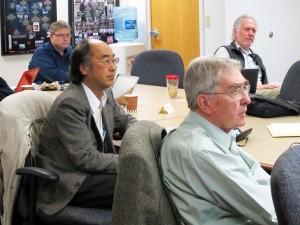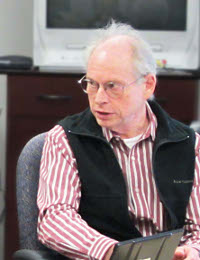
The GDE Executive Committee in session. Shown from left to right are Nick Walker, Toshiaki Tauchi, Ewan Paterson and Marc Ross. Image: ILC
The Global Design Effort (GDE) Executive Committee met face to face in Washington, DC, from 8-9 February at the offices of the American Physical Society. The GDE Executive Committee is the senior responsible body for the GDE and advises me on the broad range of science and policy issues involved in directing our efforts. Being distributed around the globe, meeting face to face takes special effort and lots of travel. At the Washington DC meeting, we covered many topics. One topic of special importance was reaching agreement on the detailed plan for producing the Technical Design Report (TDR), including its length and level of detail, as well as how to ensure the backup documentation will be readily available.

Nick Walker presented a plan to produce a concise TDR, having accessible backup through a well-organised EDMS system
The TDR will be a self-standing comprehensive document, containing a report on the accomplishments and plans for the ILC R&D programme, a detailed section on the updated accelerator design, a new costing of the ILC project and a Project Implementation Planning section.
We have made a considerable investment in developing a modern Electronic Data Management System (EDMS) for the GDE, and we plan to organise the backup TDR documentation to be made available through that system. Our goal is to produce consistent and integrated documentation for the TDR baseline, including the large amount of technical detail that accompanies the baseline design. John Carwardine is coordinating the TDR writing effort, while Nick Walker and Benno List are leading the backup documentation effort, using the EDMS system based at DESY.
The TDR will include our first costing of the ILC since the Reference Design Report in 2007. Much has changed since that time, including exchange rates, the baseline design, technical developments and changes, and more information on construction of the superconducting radiofrequency system. At the Washington, DC, Executive Committee meeting, Gerry Dugan presented a TDR costing plan, beginning with cost guidelines established at the 2011 Linear Collider Workshop and refined during the recent Baseline Technical Reviews. Cost reviews will be held for the various subsystems during the coming Korean workshop in April. By late spring, we should have results of industrial studies we have commissioned for the cavities and cryomodules, and we expect to have independent estimates for conventional facilities in the three regions by summer. Our first full TDR costing should then be produced by this summer, giving us time to “scrub” these costs by looking carefully at possible areas of cost reduction.
Overall, we remain on course to produce the ILC TDR by the end of the year. Face to face Executive Commitee meetings, like the one in Washington, are especially valuable in a distributed collaboration, where the leadership primarily meets via WebEx. We had full attendance of the EC members in Washington and this enabled us to grapple interactively on a wide range of issues.



Recent Comments